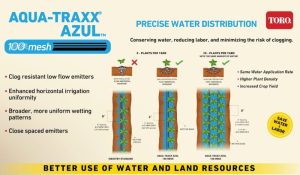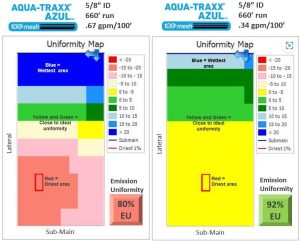Toro has announced two easy-to-use “how-to” guides on subsurface drip irrigation (SDI) and mint production. The SDI guide helps producers adopt systems for field crops such as corn, cotton, soybeans, sugarcane, alfalfa and mint. The mint guide profiles Idaho mint producer and President of the Mint Association, Bob McKellip, and reveals the success he achieved by using SDI through two harvests*. Both brochures are available in English and Spanish in our drip irrigation literature archive.
The SDI guide was written on the heels of recent news and several case studies that show, in spite of recent droughts, producers have harvested record crops by utilizing subsurface drip irrigation. The guide seeks to educate growers on the benefits of SDI and provides considerations and tools for designing SDI systems. The guide begins by providing an overview of the technology, along with a written and graphical summary of the benefits, which include increased yields, decreased costs and water use, improved ability to farm in drought conditions, and improved flexibility and convenience.
The SDI guide also explains system set-up and the lateral selection process. Selecting the correct lateral model is integral for successful SDI systems, but is often challenging because emitter flow rates range from .07 gph to .53 gph, emitter spacings range from 6” to 24”, internal diameters range from 5/8” to 1 3/8”, and wall thicknesses range from 4 mil to 15 mil. To help ease the selection process, Toro developed an innovative four-step lateral selection tool to help producers translate soil, water and crop information into specific lateral choices.
Users can choose from Toro’s wide lateral product offering, including Aqua-Traxx® premium drip tape, Aqua-Traxx® PC (pressure-compensating) drip tape, and Toro’s new Neptune flat emitter dripline. The lateral selection guide helps users quickly narrow the list of eligible models that will successfully satisfy grower objectives given site-specific soil, water, and crop condition. This unique, innovative format of translating gpm/acre or inches/hour into a lateral choice will make SDI lateral specification easier for irrigation dealers and producers, alike.
The SDI guide also summarizes important considerations in SDI design, installation, operation, and maintenance. In addition, the SDI guide points to other helpful resources, such as Toro’s Micro-Irrigation Owner’s Manual, AquaFlow drip irrigation design software, and crop-specific case studies, such as alfalfa, corn, cotton, potatoes, processing tomatoes, and, most recently, mint.
The mint guide documents the success that producer Bob McKellip has enjoyed by using SDI on mint planted in the fall of 2011 near Nampa, Idaho. “With drip irrigation, the result is a better crop, no runoff and a cleaner watershed,” explains McKellip. “I harvested unheard-of yields on second-year mint – 188 pounds of mint oil per acre!” In addition to 47% more pounds of mint on his SDI fields versus his furrow-irrigated fields, he decreased water usage by 41%, reduced fertilizer usage by 50%, and saved $46/acre in fertilizer application costs. “This was in spite of record heat, minimal rainfall, and variable soils with differing water holding capacities.” The guide also reviews McKellip’s SDI system details including the lateral model, depth of burial, application rates, and cites other benefits including power savings; reduced weed growth, cultivation costs, and labor; improved resistance to insects and disease; the ability to rotate to marginal soils; and, the ability to grow higher value crops with conserved water.
Click here to download the SDI guide (Click here to download the SDI guide in Spanish).
Click here to download the Mint guide (Click here to download the Mint guide in Spanish).
*Results based on specific conditions – variations may apply.




